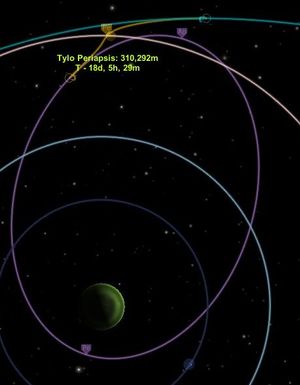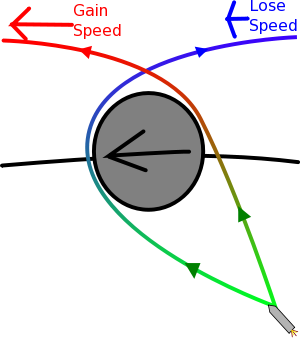Difference between revisions of "Tutorial: Gravity Assist"
Zombie Elvis (talk | contribs) m (I left out the efficiency part...) |
SlayerGames (talk | contribs) m (Fixed categories) |
||
| (27 intermediate revisions by 12 users not shown) | |||
| Line 1: | Line 1: | ||
| − | [[File:Gravitational slingshot.svg|right|thumb|Over-simplified example of gravitational slingshot: the spacecraft's velocity changes by up to twice the | + | [[File:Gravitational slingshot.svg|right|thumb|Over-simplified example of gravitational slingshot: the spacecraft's velocity (v) changes by up to twice the body's orbital velocity (U).]] |
| − | A ''' | + | A '''gravity assist''', a.k.a. '''swing-by''' or '''slingshot''', is a fuel-efficient method to change your [[craft]]'s speed and heading using the orbital velocity and gravity of a [[satellite]] (commonly a planet/moon) orbiting the same body as you. By flying either 'ahead' or 'behind' the other body, you can use its gravity to 'pull' you [[prograde]] (or [[retrograde]]), changing your velocity around the primary without any need to fire your engines. |
| + | It's even possible to repeatedly use a body for a gravity assist, provided you remain in your original SOI and not on an escape trajectory. Repeated assists are most easily done by using planets. After the previous assist you will most likely need to perform a small course correction to encounter the satellite again. | ||
*'''Length:''' 30 minutes | *'''Length:''' 30 minutes | ||
| Line 10: | Line 11: | ||
== How to do it == | == How to do it == | ||
| − | In | + | In example one, we will leave from [[Kerbin]] to a trajectory to [[Duna]] by performing a gravity assist around the [[Mun]]. Usually you need to raise your apoapsis to 85 million meters to escape from Kerbin. With this method we will just have to get to the Mun orbit (12 million meters). This will save you fuel for several hundred m/s of delta-v. |
| − | # Get your ship into a circular Low Kerbin Orbit | + | # Get your ship into a circular Low Kerbin Orbit. |
# Zoom out so you can see the orbit of Kerbin around the sun. | # Zoom out so you can see the orbit of Kerbin around the sun. | ||
| − | # Arrange for a fly-by with the | + | # Arrange for a fly-by with the Mun just like you learned in the "Going to the Mun" ingame tutorial, but arrange for it to happen while the Mun is heading into the direction you want to go. In this case we want to get further way from the sun, so do it when the Mun is going in that direction - the moment it intersects the orbit of Kerbin. |
| − | # Accelerate time until you reach the sphere of influence of the | + | # Accelerate time until you reach the sphere of influence of the Mun |
| − | # Now plan another course correction maneuver. The maneuver is more effective when you are close, so try to pass the | + | # Now plan another course correction maneuver. The maneuver is more effective when you are close, so try to pass the Mun as close as possible without colliding. Your Mun periapsis needs to be behind Mun on Muns trajectory. When you pass in front of Mun, you will lose speed instead of gaining it. Also watch the declination of your trajectory - when it gets too high it will be problematic. |
| − | # Accelerate time until you left the SoI of the | + | # Accelerate time until you left the SoI of the Mun. |
| − | # When you check the map you will notice that you are on a much wider orbit than you were before the | + | # When you check the map you will notice that you are on a much wider orbit than you were before the Mun fly-by (likely with an apoapsis beyond Minmus orbit), but it's not a Kerbin escape trajectory yet. The Mun hasn't yet given you all the speed it can. |
| − | # So perform another correction maneuver which leads you to another close | + | # So perform another correction maneuver which leads you to another close Mun fly-by and again try to pass it as close as possible. The best moment to perform this maneuver is usually when you are furthest away from Mun. |
| − | Congratulations, you | + | Congratulations, you are now on a trajectory toward Duna, or at least on an orbit that can get to it! You could use a similar trick with Ike to escape Duna. |
| − | == | + | In example two, we will use the gravity of Kerbin to get ourselves to [[Jool]]. This is especially useful for heavy probes like orbiters and manned missions, but useless for probes that are just using it as a flyby. |
| + | |||
| + | # Get your ship into a circular Low Kerbin Orbit. | ||
| + | # Set up a maneuver node somewhere along the orbit on the night side of Kerbin. | ||
| + | # Pull the prograde vector until you get into a heliocentric orbit, then pull it some more until the time to apoapsis is at least one year. When you get to it, execute the node. | ||
| + | # Warp until you exit Kerbin's SOI, then set up a maneuver node at the apoapsis. | ||
| + | # Pull the retrograde vector until you get an encounter with Kerbin. | ||
| + | # Warp to the node and execute it. Along the way, it is best to fine-tune the trajectory, getting close enough for a Joolean encounter. Remember not to go below 70,000 meters. Execute the correction maneuvers and then warp until you get to the SOI of Kerbin. | ||
| + | # When you get to the SOI of Kerbin, make sure to possibly do science tests, or, if you are using RemoteTech, use it as the final window for quicker communication. | ||
| + | # After you exit Kerbin's SOI, you can make a couple more TCM. | ||
| + | |||
| + | Congratulations, you are now on a trajectory set for Jool! | ||
| + | |||
| + | == Gravity brake == | ||
[[File:Gravity Assist.svg|right|thumb|Pass in front of a celestial body to brake and behind a celestial body to accelerate]] | [[File:Gravity Assist.svg|right|thumb|Pass in front of a celestial body to brake and behind a celestial body to accelerate]] | ||
[[File:Jool gravity assist deceleration.jpg|left|thumb|Using a reverse gravity assist around Tylo to get into a Jool orbit. The necessary course correction required less fuel than getting close enough to Jool for an [[aerobrake]] maneuver. It is also much safer than aerobraking.]] | [[File:Jool gravity assist deceleration.jpg|left|thumb|Using a reverse gravity assist around Tylo to get into a Jool orbit. The necessary course correction required less fuel than getting close enough to Jool for an [[aerobrake]] maneuver. It is also much safer than aerobraking.]] | ||
| − | Should you enter the Duna-Ike system in a suitable trajectory, you can perform a | + | Should you enter the Duna-Ike system in a suitable trajectory, you can perform a gravity brake to lose speed instead of gaining it. To do so just do an Ike flyby. In order to lose speed instead of gaining it, your Ike periapsis needs to be in front of Ike's trajectory instead of behind it. |
| + | |||
| + | The same could go for the Joolean trajectory. However, if you had burned relatively close to the planet and are making a periapsis-raising burn, you could use Tylo's gravity to decrease your orbital period. | ||
== Powered Gravity assist == | == Powered Gravity assist == | ||
To get even more out of a gravity assist, you can perform a powered gravity assist. As you know, accelerating at your periapsis has the greatest effect on your apoapsis. This still applies to your periapsis during a gravity assist. When you accelerate during your fly-by, this fuel is used very efficiently to increase the apoapsis of your final trajectory. This is, however, a very difficult technique, because it is hard to control your final trajectory, even when using a maneuver node. | To get even more out of a gravity assist, you can perform a powered gravity assist. As you know, accelerating at your periapsis has the greatest effect on your apoapsis. This still applies to your periapsis during a gravity assist. When you accelerate during your fly-by, this fuel is used very efficiently to increase the apoapsis of your final trajectory. This is, however, a very difficult technique, because it is hard to control your final trajectory, even when using a maneuver node. | ||
| + | |||
| + | == Real Life == | ||
| + | For those who may be wondering about the physics at work here, or crying "unrealistic game engine exploit": this maneuver ''is'' an exploit of sorts, but an exploitation of the laws of physics rather than a glitch. Also called a gravitational slingshot maneuver, this is a very common trick used by real-world space programs to save vast amounts of fuel on interplanetary missions. What is essentially happening here is that you are using the planet as a giant trebuchet. As the spacecraft approaches periapsis, the two become tethered together by gravity. The craft is dragged slightly in the direction of the planet's motion, and the planet is dragged slightly in the direction of the spacecraft. The effect on the planet is incredibly tiny, small enough that this part of the equation can be ignored both by the game and in the real world. For the much smaller spacecraft, however, it's a significant gain in kinetic energy, which hurls it back out into space like a boulder at a castle wall. | ||
== See also == | == See also == | ||
* [https://www.youtube.com/watch?v=lIORB7svhaA Using Gravity Assists To Save Fuel] by Scott Manley on YouTube | * [https://www.youtube.com/watch?v=lIORB7svhaA Using Gravity Assists To Save Fuel] by Scott Manley on YouTube | ||
| − | |||
* {{Wikipedia|Gravity assist}} | * {{Wikipedia|Gravity assist}} | ||
| − | [[Category:Tutorials]] | + | [[Category:Tutorials|Gravity Assist]] |
| − | [[Category:Maneuvers]] | + | [[Category:Maneuvers|Gravity Assist]] |
Latest revision as of 19:58, 2 May 2019
A gravity assist, a.k.a. swing-by or slingshot, is a fuel-efficient method to change your craft's speed and heading using the orbital velocity and gravity of a satellite (commonly a planet/moon) orbiting the same body as you. By flying either 'ahead' or 'behind' the other body, you can use its gravity to 'pull' you prograde (or retrograde), changing your velocity around the primary without any need to fire your engines.
It's even possible to repeatedly use a body for a gravity assist, provided you remain in your original SOI and not on an escape trajectory. Repeated assists are most easily done by using planets. After the previous assist you will most likely need to perform a small course correction to encounter the satellite again.
- Length: 30 minutes
- Difficulty: Medium
- For version: 0.18.4
How to do it
In example one, we will leave from Kerbin to a trajectory to Duna by performing a gravity assist around the Mun. Usually you need to raise your apoapsis to 85 million meters to escape from Kerbin. With this method we will just have to get to the Mun orbit (12 million meters). This will save you fuel for several hundred m/s of delta-v.
- Get your ship into a circular Low Kerbin Orbit.
- Zoom out so you can see the orbit of Kerbin around the sun.
- Arrange for a fly-by with the Mun just like you learned in the "Going to the Mun" ingame tutorial, but arrange for it to happen while the Mun is heading into the direction you want to go. In this case we want to get further way from the sun, so do it when the Mun is going in that direction - the moment it intersects the orbit of Kerbin.
- Accelerate time until you reach the sphere of influence of the Mun
- Now plan another course correction maneuver. The maneuver is more effective when you are close, so try to pass the Mun as close as possible without colliding. Your Mun periapsis needs to be behind Mun on Muns trajectory. When you pass in front of Mun, you will lose speed instead of gaining it. Also watch the declination of your trajectory - when it gets too high it will be problematic.
- Accelerate time until you left the SoI of the Mun.
- When you check the map you will notice that you are on a much wider orbit than you were before the Mun fly-by (likely with an apoapsis beyond Minmus orbit), but it's not a Kerbin escape trajectory yet. The Mun hasn't yet given you all the speed it can.
- So perform another correction maneuver which leads you to another close Mun fly-by and again try to pass it as close as possible. The best moment to perform this maneuver is usually when you are furthest away from Mun.
Congratulations, you are now on a trajectory toward Duna, or at least on an orbit that can get to it! You could use a similar trick with Ike to escape Duna.
In example two, we will use the gravity of Kerbin to get ourselves to Jool. This is especially useful for heavy probes like orbiters and manned missions, but useless for probes that are just using it as a flyby.
- Get your ship into a circular Low Kerbin Orbit.
- Set up a maneuver node somewhere along the orbit on the night side of Kerbin.
- Pull the prograde vector until you get into a heliocentric orbit, then pull it some more until the time to apoapsis is at least one year. When you get to it, execute the node.
- Warp until you exit Kerbin's SOI, then set up a maneuver node at the apoapsis.
- Pull the retrograde vector until you get an encounter with Kerbin.
- Warp to the node and execute it. Along the way, it is best to fine-tune the trajectory, getting close enough for a Joolean encounter. Remember not to go below 70,000 meters. Execute the correction maneuvers and then warp until you get to the SOI of Kerbin.
- When you get to the SOI of Kerbin, make sure to possibly do science tests, or, if you are using RemoteTech, use it as the final window for quicker communication.
- After you exit Kerbin's SOI, you can make a couple more TCM.
Congratulations, you are now on a trajectory set for Jool!
Gravity brake

Should you enter the Duna-Ike system in a suitable trajectory, you can perform a gravity brake to lose speed instead of gaining it. To do so just do an Ike flyby. In order to lose speed instead of gaining it, your Ike periapsis needs to be in front of Ike's trajectory instead of behind it.
The same could go for the Joolean trajectory. However, if you had burned relatively close to the planet and are making a periapsis-raising burn, you could use Tylo's gravity to decrease your orbital period.
Powered Gravity assist
To get even more out of a gravity assist, you can perform a powered gravity assist. As you know, accelerating at your periapsis has the greatest effect on your apoapsis. This still applies to your periapsis during a gravity assist. When you accelerate during your fly-by, this fuel is used very efficiently to increase the apoapsis of your final trajectory. This is, however, a very difficult technique, because it is hard to control your final trajectory, even when using a maneuver node.
Real Life
For those who may be wondering about the physics at work here, or crying "unrealistic game engine exploit": this maneuver is an exploit of sorts, but an exploitation of the laws of physics rather than a glitch. Also called a gravitational slingshot maneuver, this is a very common trick used by real-world space programs to save vast amounts of fuel on interplanetary missions. What is essentially happening here is that you are using the planet as a giant trebuchet. As the spacecraft approaches periapsis, the two become tethered together by gravity. The craft is dragged slightly in the direction of the planet's motion, and the planet is dragged slightly in the direction of the spacecraft. The effect on the planet is incredibly tiny, small enough that this part of the equation can be ignored both by the game and in the real world. For the much smaller spacecraft, however, it's a significant gain in kinetic energy, which hurls it back out into space like a boulder at a castle wall.
See also
- Using Gravity Assists To Save Fuel by Scott Manley on YouTube
- Gravity assist on Wikipedia

